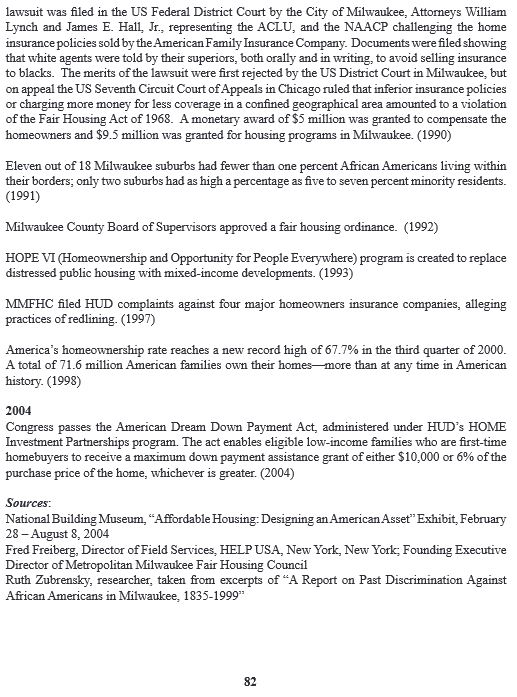 |
| (Image from UW-Milw CED report, The Economic State of Milwaukee, 1990-2008) |
Included here are some graphics detailing the persistent black-white segregation that exists in the Milwaukee metro area. This information has been compiled in connection with the post "Silent Reflection for Each of the Victims of Violence Within an American City." Several things to note in what follows:
1) By any measure, the Milwaukee metro area is one of the most racially segregated places in the country.
2) Milwaukee's segregation ranking against other metro areas has increased over recent decades (1980-2010).
3) Among the most segregated metro areas in the country, Milwaukee leads, by far, in its lack of "suburbanization" of its minority population.
4) National averages for black-white segregation peaked around 1965, and have since seen a steady decline.
5) For a graphical explanation of segregation measurement methodology see images from the 2000 U.S. Census Bureau report presented below.
6) For a discussion of Milwaukee's segregated housing environment see the historic timeline (1896-2004) presented in the 2005 report below.
7) See post Milwaukee Area Population - Changes and Characteristics for additional comments.
The following image is taken from the City of Milwaukee, July, 2014, draft report, Growing Prosperity, An action agenda for economic development in the city of Milwaukee (http://media.jrn.com/documents/growing-prosperity-draft-7-2-14.pdf):
The following 2 tables are taken from the U of MI Population Studies Center (PSC) Institute for Social Research, New Racial Segregation Measures for Large Metropolitan Areas: Analysis of the 1990-2010 Decennial Censuses, which is based on the work of William Frey, Brookings Institution and Univ. of MI Social Science Data Analysis Network's analysis of 1990, 2000, and 2010 Census Decennial Census tract data (http://www.psc.isr.umich.edu/dis/census/segregation2010.html). Data for 2010 is also displayed at a companion site, Census Scope 2010 (http://censusscope.org/2010Census/).
Note (copied verbatim from PSC site):
Segregation Indices are Dissimilarity Indices (D) that measure the degree to which the minority group is distributed differently than whites aross census tracts. They range from 0 (complete integration) to 100 (complete segregation) where the value indicates the percentage of the minority group that needs to move to be distributed exactly like whites.
Note: In this analysis all racial groups (whites, blacks, asians and other races) are non-Hispanic (NH) members of those races. Hispanics are shown as a separate category.
 |
| (Milwaukee ranking, D: 1-2010, 2-2000, 3-1990) |
 |
| (Milwaukee ranking, D: 9-2010, 10-2000, 14-1990) |
The following 4 images are taken from a July, 2013, report by the UW-Milwaukee Center for Economic Development, titled, Perspectives on the Current State of the Milwaukee Economy (http://www4.uwm.edu/ced/publications/perspectives.pdf):
 |
| (NH - non-Hispanic) |
The following 7 images are taken from a March, 2011, report for Project US 2010, titled, The Persistence of Segregation in the Metropolis: New Findings from the 2010 Census, by John R. Logan (Brown Univ.) and Brian Stults (FL State Univ.) (http://www.s4.brown.edu/us2010/Data/Report/report2.pdf). Slightly different units of analysis are used here in this report, resulting in numbers (D) that vary slightly from those that are presented above by Frey:
 |
| (Note: Milwaukee rankings identical to Frey findings above, however D values presented are slightly different) |
 |
| (Milwaukee ranking, I: 5-2010, 9-2000, 8-1990, 14-1980) |
 |
| (Data for U.S. average Dissimilarity, and Isolation (given in neighborhood breakdown)) |
 |
| (U.S. metro average; note that "exposure" = Isolation Index) |
 |
| (Average neighborhood composition for each ethnic group, showing Isolation numbers from summary table above) |
The following 10 images are taken from chapters 2 & 5 of the U.S. Census Bureau Report, Racial and Ethnic Residential Segregation in the United States: 1980-2000 (https://www.census.gov/hhes/www/housing/housing_patterns/pdftoc.html). Slightly different units of analysis are used here in this report, resulting in numbers (D) that vary slightly from those that are presented above by Frey. Residential segregation measurement methodology is also explained:
 |
| (See Table 2-1 below for Index names) |
The following 12 images are of a timeline (1896-2004) outlining both local and national housing policies and practices impacting the Milwaukee metro area, and is taken from the appendix of an August, 2005, report by the Metropolitan Milwaukee Fair Housing Council, titled City of Milwaukee, Impediments to Fair Housing (http://www.ci.mil.wi.us/ImageLibrary/User/jsteve/MilwaukeeAI.pdf):



























If some one wants to be updated with most recent technologies after that he must be pay a quick visit this web site and be up to date everyday.
ReplyDelete